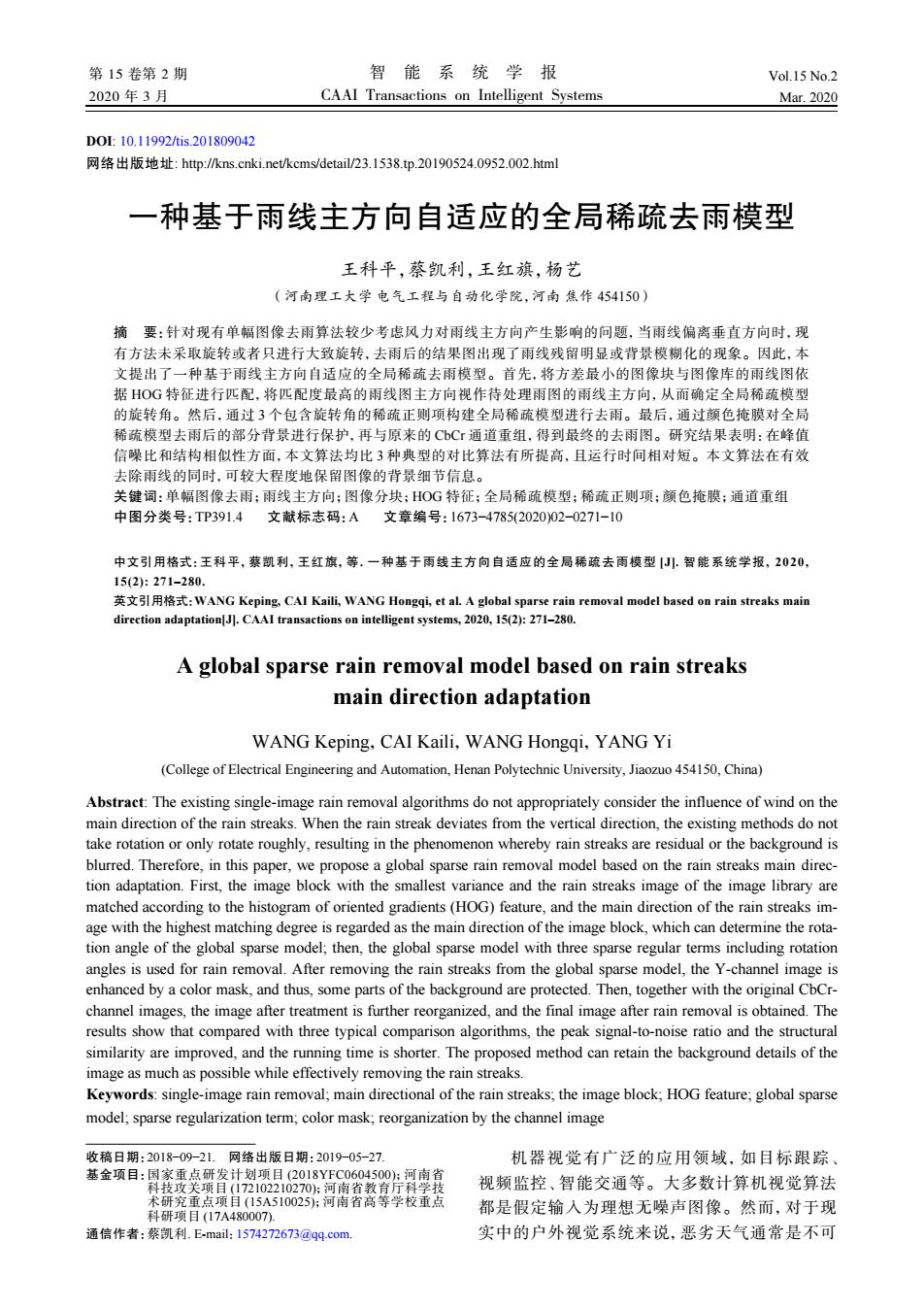正在加载图片...

第15卷第2期 智能系统学报 Vol.15 No.2 2020年3月 CAAI Transactions on Intelligent Systems Mar.2020 D0:10.11992/tis.201809042 网络出版地址:http:/kns.cnki.net/kcms/detail/23.1538.tp.20190524.0952.002.html 一种基于雨线主方向自适应的全局稀疏去雨模型 王科平,蔡凯利,王红旗,杨艺 (河南理工大学电气工程与自动化学院,河南焦作454150) 摘要:针对现有单幅图像去雨算法较少考虑风力对雨线主方向产生影响的问题,当雨线偏离垂直方向时,现 有方法未采取旋转或者只进行大致旋转,去雨后的结果图出现了雨线残留明显或背景模糊化的现象。因此,本 文提出了一种基于雨线主方向自适应的全局稀疏去雨模型。首先,将方差最小的图像块与图像库的雨线图依 据HOG特征进行匹配,将匹配度最高的雨线图主方向视作待处理雨图的雨线主方向,从而确定全局稀疏模型 的旋转角。然后,通过3个包含旋转角的稀疏正则项构建全局稀疏模型进行去雨。最后,通过颜色掩膜对全局 稀疏模型去雨后的部分背景进行保护,再与原来的CbCr通道重组,得到最终的去雨图。研究结果表明:在峰值 信噪比和结构相似性方面,本文算法均比3种典型的对比算法有所提高,且运行时间相对短。本文算法在有效 去除雨线的同时,可较大程度地保留图像的背景细节信息。 关键词:单幅图像去雨;雨线主方向;图像分块;HOG特征;全局稀疏模型;稀疏正则项;颜色掩膜;通道重组 中图分类号:TP391.4文献标志码:A文章编号:1673-4785(2020)02-0271-10 中文引用格式:王科平,蔡凯利,王红旗,等.一种基于雨线主方向自适应的全局稀疏去雨模型智能系统学报,2020, 15(2):271-280. 英文引用格式:VANG Keping,CAI Kaili,,WANG Hongqi,,etal.A global sparse rain removal model based on rain streaks main direction adaptationJ].CAAI transactions on intelligent systems,2020,15(2):271-280 A global sparse rain removal model based on rain streaks main direction adaptation WANG Keping,CAI Kaili,WANG Hongqi,YANG Yi (College of Electrical Engineering and Automation,Henan Polytechnic University,Jiaozuo 454150,China) Abstract:The existing single-image rain removal algorithms do not appropriately consider the influence of wind on the main direction of the rain streaks.When the rain streak deviates from the vertical direction,the existing methods do not take rotation or only rotate roughly,resulting in the phenomenon whereby rain streaks are residual or the background is blurred.Therefore,in this paper,we propose a global sparse rain removal model based on the rain streaks main direc- tion adaptation.First,the image block with the smallest variance and the rain streaks image of the image library are matched according to the histogram of oriented gradients(HOG)feature,and the main direction of the rain streaks im- age with the highest matching degree is regarded as the main direction of the image block,which can determine the rota- tion angle of the global sparse model:then,the global sparse model with three sparse regular terms including rotation angles is used for rain removal.After removing the rain streaks from the global sparse model,the Y-channel image is enhanced by a color mask,and thus,some parts of the background are protected.Then,together with the original CbCr- channel images,the image after treatment is further reorganized,and the final image after rain removal is obtained.The results show that compared with three typical comparison algorithms,the peak signal-to-noise ratio and the structural similarity are improved,and the running time is shorter.The proposed method can retain the background details of the image as much as possible while effectively removing the rain streaks. Keywords:single-image rain removal;main directional of the rain streaks;the image block;HOG feature;global sparse model;sparse regularization term;color mask;reorganization by the channel image 收稿日期:2018-09-21.网络出版日期:2019-05-27 机器视觉有广泛的应用领域,如目标跟踪、 基金项目:国家重点研发计划项目(2018Y℉C0604500:河南省 科技攻关项目(1721022I0270):河南省教育厅科学技 视频监控、智能交通等。大多数计算机视觉算法 术研究重点项目(15A510025):河南省高等学校重点 科研项目(17A480007). 都是假定输入为理想无噪声图像。然而,对于现 通信作者:蔡凯利.E-mail:1574272673@gq.com 实中的户外视觉系统来说,恶劣天气通常是不可DOI: 10.11992/tis.201809042 网络出版地址: http://kns.cnki.net/kcms/detail/23.1538.tp.20190524.0952.002.html 一种基于雨线主方向自适应的全局稀疏去雨模型 王科平,蔡凯利,王红旗,杨艺 (河南理工大学 电气工程与自动化学院,河南 焦作 454150) 摘 要:针对现有单幅图像去雨算法较少考虑风力对雨线主方向产生影响的问题,当雨线偏离垂直方向时,现 有方法未采取旋转或者只进行大致旋转,去雨后的结果图出现了雨线残留明显或背景模糊化的现象。因此,本 文提出了一种基于雨线主方向自适应的全局稀疏去雨模型。首先,将方差最小的图像块与图像库的雨线图依 据 HOG 特征进行匹配,将匹配度最高的雨线图主方向视作待处理雨图的雨线主方向,从而确定全局稀疏模型 的旋转角。然后,通过 3 个包含旋转角的稀疏正则项构建全局稀疏模型进行去雨。最后,通过颜色掩膜对全局 稀疏模型去雨后的部分背景进行保护,再与原来的 CbCr 通道重组,得到最终的去雨图。研究结果表明:在峰值 信噪比和结构相似性方面,本文算法均比 3 种典型的对比算法有所提高,且运行时间相对短。本文算法在有效 去除雨线的同时,可较大程度地保留图像的背景细节信息。 关键词:单幅图像去雨;雨线主方向;图像分块;HOG 特征;全局稀疏模型;稀疏正则项;颜色掩膜;通道重组 中图分类号:TP391.4 文献标志码:A 文章编号:1673−4785(2020)02−0271−10 中文引用格式:王科平, 蔡凯利, 王红旗, 等. 一种基于雨线主方向自适应的全局稀疏去雨模型 [J]. 智能系统学报, 2020, 15(2): 271–280. 英文引用格式:WANG Keping, CAI Kaili, WANG Hongqi, et al. A global sparse rain removal model based on rain streaks main direction adaptation[J]. CAAI transactions on intelligent systems, 2020, 15(2): 271–280. A global sparse rain removal model based on rain streaks main direction adaptation WANG Keping,CAI Kaili,WANG Hongqi,YANG Yi (College of Electrical Engineering and Automation, Henan Polytechnic University, Jiaozuo 454150, China) Abstract: The existing single-image rain removal algorithms do not appropriately consider the influence of wind on the main direction of the rain streaks. When the rain streak deviates from the vertical direction, the existing methods do not take rotation or only rotate roughly, resulting in the phenomenon whereby rain streaks are residual or the background is blurred. Therefore, in this paper, we propose a global sparse rain removal model based on the rain streaks main direction adaptation. First, the image block with the smallest variance and the rain streaks image of the image library are matched according to the histogram of oriented gradients (HOG) feature, and the main direction of the rain streaks image with the highest matching degree is regarded as the main direction of the image block, which can determine the rotation angle of the global sparse model; then, the global sparse model with three sparse regular terms including rotation angles is used for rain removal. After removing the rain streaks from the global sparse model, the Y-channel image is enhanced by a color mask, and thus, some parts of the background are protected. Then, together with the original CbCrchannel images, the image after treatment is further reorganized, and the final image after rain removal is obtained. The results show that compared with three typical comparison algorithms, the peak signal-to-noise ratio and the structural similarity are improved, and the running time is shorter. The proposed method can retain the background details of the image as much as possible while effectively removing the rain streaks. Keywords: single-image rain removal; main directional of the rain streaks; the image block; HOG feature; global sparse model; sparse regularization term; color mask; reorganization by the channel image 机器视觉有广泛的应用领域,如目标跟踪、 视频监控、智能交通等。大多数计算机视觉算法 都是假定输入为理想无噪声图像。然而,对于现 实中的户外视觉系统来说,恶劣天气通常是不可 收稿日期:2018−09−21. 网络出版日期:2019−05−27. 基金项目:国家重点研发计划项目 (2018YFC0604500);河南省 科技攻关项目 (172102210270);河南省教育厅科学技 术研究重点项目 (15A510025);河南省高等学校重点 科研项目 (17A480007). 通信作者:蔡凯利. E-mail:1574272673@qq.com. 第 15 卷第 2 期 智 能 系 统 学 报 Vol.15 No.2 2020 年 3 月 CAAI Transactions on Intelligent Systems Mar. 2020